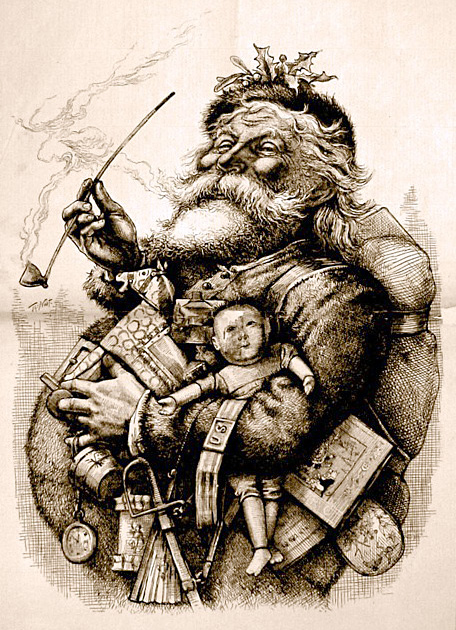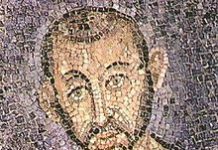(One might have different views on the Santa legend, and whether or not to present (no pun intended) this story to children, as literal truth, as a myth, as an archetype of at least some of what ‘Christmas’ means. What follows is one take. One may also ponder this article defending the Santa story, linked to also below, or this one bemoaning the commercialization of the whole Santa thing, out to sell as much as possible. Like any legend, we must take what is good, and leave out what is, well, not so good. And we wish all of our readers a very merry, joyous and holy Christmas. Christus natus est, alleluia!)
A year ago, I wrote a piece on the true significance of Christmas for Catholic Insight. That message applies as much this year, as it did last year. Many people “celebrating” Christmas, come from all sorts of religious and non-religious backgrounds, but unfortunately do not recognize or accept the real significance of Christmas. As Christians, we really should try our best not to be swept up by the artificiality and emptiness of consumerism that is so common around Christmas time. And most importantly, we mustn’t lose sight of the centrality of Christ’s birth. Coincidentally and tragically, as I mentioned George Michael last year, in the context of upholding charity throughout all times of the year (not just Christmas), he ended up passing away on Christmas Day, may the Lord of everlasting life rest his soul.
This year, I want to raise an issue which is often neglected by many Christians, concerning the character of Santa Claus. Who is he, really? I believe that to some extent the figure of Santa Claus has evolved to certain proportions that may have some troubling theological consequences in the future for children, if not dealt with care.
The story of Santa originates with St. Nicholas, a bishop from Myra in what was known as Asia Minor. Today, this area would be identified as Turkey. St. Nicholas was a generous and kind man who helped the poor and distributed gifts. Throughout the Western world, from the 16th century onward, St. Nicholas evolved into Santa Claus. This character of Santa that we have come to identify as having a long white beard and hair, wearing a red and white robe and hat, black boots and glasses, who lives in the North Pole, and flies around the world on Christmas Eve, on a sleigh led by Rudolf the red nosed reindeer and eight other reindeer, is one that has evolved into a quasi-divine fantastical legend possessing miraculous powers, such as quasi-omniscience, quasi-omnipresence and quasi-omnibenevolence. The question is: should such a belief be encouraged for our children?
To be sure, on the one hand, the metaphor of Santa Claus, in principle can function well to inspire awe and mystery, and anticipation in children, which are certainly valuable things. Nathan Stone wrote a wonderful piece for Crisis Magazine which takes this line of thought, it is titled: “In Defense of Santa Claus.” We need only examine the works of CS Lewis and JRR Tolkien to know that myth and imagination certainly have many uses including pedagogical purposes to relay deep Christian truths. Probably one of the most masterful minds to demonstrate this was the Swiss psychiatrist, Carl Jung, with his study of archetypes as they are developed in the collective unconscious. Something that professor and clinical psychologist, Jordan Peterson, has interestingly spent a significant time lecturing and writing about. One can explore those in great depth through Peterson’s YouTube videos. Interestingly, Peterson is leading many young men back to their Christian roots through his evocative presentations which explore Biblical metaphors and archetypes.
I do not disagree with these approaches, I think they have their deep uses and significances, but, we must also be on guard for the literal type of attacks on the faith, such as the argumentation of Neo-Atheists who like to equate disbelief in Santa Claus with God. This is because we live in a culture that is deeply embedded within both scientific and metaphysical materialism. Just as much as we must restore belief in myth and a proper awe of reality, I think we must confront these other challenges as well. If we do not do this with good measure, it can have somewhat dangerous theological consequences. One need only take a poll of how Christians beliefs are deeply shaken upon entering university.
For our purposes, let us examine how disbelief in Santa Claus can lead to disbelief in theological truths. Take for instance, the lyrics to the song, Santa Claus is Coming to Town which illustrates this type of foreknowledge and even capacity for higher moral judgment: “Well, he knows when you are sleeping He knows when you’re awake He knows if you’ve been bad or good. So be good for goodness sake. So, you better watch out, you better not cry. Don’t be poutin’ ’cause I’m telling you why Santa Claus is coming Yeah, he is coming to town…”
In response, I have told my daughter that Santa only gets his miraculous powers from God. It was the best compromise I could come up with, since the story of Santa was inculcated to her, from an early age. She has even said recently, when I made a comment about the packaging of presents: “Well, it doesn’t matter since Santa’s elves are making them from scratch in the North Pole, unless everybody has been lying to me.” Her skeptical mind is starting to discriminate elements of the story. The tragedy that will come with the eventual doubt of Santa’s existence will be the beginning of the loss of her innocence and wonder about the universe. I also fear that when she begins to doubt the existence of Santa, she will begin to ask herself the following question: “what else has been kept from me?”
Readers may wonder as to why I haven’t explained the nonexistence of a literal Santa to her. The reason is twofold: one minor and one major reason. The minor reason is out of respect for her mother’s wishes, who has been significantly invested in our daughter’s belief in Santa. The major reason is to preserve her innocence and wonderment of the world, as far as I possibly can. Last time, I checked she still believed in the Tooth Fairy and the Easter Bunny. My concern is more with the potential repercussions of her eventual disbelief in Santa.
Perhaps, after asking such questions of truth, she may or may not start doubting the existence of God. We must be honest with ourselves, given our cultural climate: this is certainly a strong possibility for most Christian children. I know, from personal experience, that once I began to lose my enchantment with the world, so too began my skepticism of theological truths. Even though my objections were not tempered by good argumentation, as is the case with many disbelievers, they were rooted in some healthy skepticism. In order to help cope with this, I want to outline some brief arguments/strategies to help other Christian parents cope with such a situation, if it were to arise.
The first thing to point out to your child, who may begin to show skepticism toward God’s existence because of disbelief in a literal Santa, is that most adults who do not believe in a literal Santa, still believe in God. Second, the reason we do not believe in a literal Santa is because we have no evidence of his existence (as well as violating some basic rules of physics and metaphysics, Ed.). Has anyone ever witnessed him on Christmas Eve travelling the world on his sleigh and distributing presents? Have we seen any evidence of his toy factory in the North Pole? What about elves? Indeed, the reason we do not believe in Santa Claus is because we lack any evidence of such a character truly existing. Now, a skeptic may object and argue, “well it could be that Santa is invisible and so are the reindeer and elves.” A somewhat clever strategy, even though it still does little to demonstrate why no presents are ever delivered by this invisible being, since parents are the ones placing the presents under the tree on Christmas Eve. Moreover, this perpetually invisible being would not resemble Santa anymore, but rather some transcendent quasi-angelic spiritual being.
In contrast, for the existence of God, we have plenty of good arguments and evidence to demonstrate His existence. We have many signposts to a transcendent reality. Take for instance, that the past is finite with a definite beginning which calls for its explanation in an a-temporal and transcendent cause, as argued in the Kalam Cosmological Argument. There are plenty of others such as the principle of sufficient reason (Leibniz’s contingency argument), the teleological argument, the axiological (moral) argument, the argument from consciousness, the ontological argument, the usefulness of mathematics in the natural sciences which outlines the intelligibility of the universe, the historical evidence of Jesus’ resurrection and His own divine self-understanding, and many others. Interestingly, once the deep implications of these arguments are pondered and realized, it can help renew and even deepen our enchantment with the world and our faith. Reason is not opposed to faith, they are inextricably linked in profound ways. The deeper my understanding of these arguments, the deeper that my faith has grown. Thus, I do believe we must help reverse our culture’s disenchantment with the universe, and the use of legends and imaginative apologetics, a la Lewis and Tolkien with fantasy narratives, we must also foster a faith grounded in reason.
Furthermore, I personally believe, as adults, there are plenty of places to find “awe” in the world, not least nature itself. We need only look at the scientific discoveries of the past 100 years. Ponder Big Bang cosmology, quantum mechanics, the intricacy of a cell and its components, the miracle of human life and consciousness and so on and so forth. This is where we can find not just the evidence of God’s handiwork but His beauty and majesty that allow for one of the greatest miracles of all: The Incarnation.
So, my advice to parents is to try to delicately balance their children’s propensity for belief in the “magical” and the wonderful mystery which Santa and other myths truly embody, which no doubt, provide hope and anticipation, with true knowledge of God, especially when they raise important questions of the faith. In other words, there is certainly goodness that comes from belief in the myth of Santa for children, and for the archetypal genre of such myths for adults. This in my view can restore a forgotten childlike innocence and visceral amazement with existence. Yet, as parents we must be prepared to give proper reasons to our children for upholding theological truths, for the time when they fall into disbelief of the literal Santa, which is also of great importance. The balance between upholding truth and preserving innocence, in our shattered world, is the difficult challenge we face, but not one we must shy away from. Both in synergy will help draw us ever closer to God.
Both parents and children, must always be prepared to give a response for the hope that lies within them, as 1 Peter 3:15 exemplifies. I encourage parents to investigate some of the arguments I listed, through the links I have provided. What could be a greater way to honor God, than by imparting truth and love to our children?
Have a blessed, joyful and peaceful Christmas!











